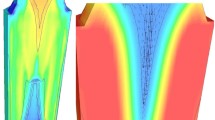Abstract
The steady-state process simulator developed by Kiranoudis et al. has been used for the detailed simulation of the Bayer process flowsheet. It consists of the digestor/flash section as well as the precipitation and washing circuits. Advanced hydrometallurgical process models for the specific unit operations involved were developed and are appropriately described. The simulation studies mainly focus on studying the overall effects of certain design parameters on the entire plant efficiency. The overall performance of the bauxite digestion section is greatly and positively affected by the free-soda concentration of the feed liquor, the corresponding concentration of solid particles, and the operation temperature of the circuit. Precipitation of alumina in crystallizers is greatly affected by the corresponding soda concentration of the washing unit product stream, indicating the importance of this section. Furthermore, ambient temperature is important to the precipitation kinetics, influencing negatively the quantitative precipitation but resulting in particle populations of higher mean diameter.
Similar content being viewed by others
Abbreviations
- ΔH j :
-
heat of reaction j
- μ i :
-
molecular weight of species i
- μ j :
-
jth moment of particle distribution leaving the crystallizer
- μ 0 j :
-
jth moment of particle distribution entering the crystallizer
- ξ j :
-
extent of reaction j
- ρ i :
-
density of component i
- ρ L :
-
density of liquid phase
- ρ s :
-
density of solid phase
- a :
-
produced particle surface rate leaving a crystallizer
- a 0 :
-
produced particle surface rate entering a crystallizer
- a w :
-
water activity in soda solution
- a i :
-
ion activity for species i
- A :
-
total particle surface in a crystallizer
- B 0 :
-
nucleation rate
- C A :
-
alumina concentration of a pulp leaving a crystallizer
- C 0 A :
-
alumina concentration of a pulp entering a crystallizer
- C Aeq :
-
saturation concentration of alumina in a pulp
- Cp i :
-
specific heat of species i
- C s :
-
soda concentration of a pulp leaving a crystallizer
- C 0 s :
-
soda concentration of a pulp entering a crystallizer
- CSD:
-
crystal size distribution
- CSTR:
-
completely stirred tank reactor
- \(f_{SiO_2 }^{DSP} \) :
-
fraction of silicon oxide precipitated as desilication product
- F i :
-
molar flow rate of species i leaving a process
- F 0 i :
-
molar flow rate of species i entering a process
- G :
-
particle growth rate
- HC:
-
hydrocyclone
- k G,k N :
-
growth and nucleation kinetic constants
- k a,k v :
-
particle distribution surface and volume shape coefficients
- k dg :
-
Bauxite digestion kinetic constant
- KD :
-
ionic equilibrium constant
- l :
-
particle diameter
- n :
-
number of particles rate leaving the crystallizer
- n 0 :
-
number of particles rate entering the crystallizer
- n 1,n 2,n 3 :
-
characteristic stoichiometric coefficients of desilication products
- N :
-
total number of particles in the crystallizer
- Na2O c ,Na2O i ,Al2O3 :
-
concentration of free soda, total soda, and alumina, respectively
- PRISMA:
-
Process Integrated Simulator for Metallurgical Applications
- Q :
-
heat produced
- Q 1 :
-
liquid phase volumetric flow rate leaving the process
- Q 0 L :
-
liquid phase volumetric flow rate entering the process
- Q s :
-
solid phase volumetric flow rate leaving the process
- Q 0 s :
-
solid phase volumetric flow rate entering the process
- r i :
-
rate of reaction
- RP:
-
ponderal ratio of alumina to soda leaving the digestor
- RP0 :
-
ponderal ratio of alumina to soda entering the digestor
- RP T :
-
theoretical ponderal ratio of alumina to soda for complete dissolution
- RP eq :
-
equilibrium ponderal ratio of alumina to soda in the digestor
- s :
-
supersaturation
- t :
-
retention time
- V L :
-
liquid phase volume
- V R :
-
reactor volume
- V s :
-
solid phase volume
- w s :
-
alumina hydrate mass flow rate leaving the crystallizer
- w 0 s :
-
alumina hydrate mass flow rate entering the crystallizer
- W s :
-
total alumina mass in the crystallizer
References
C.T. Kiranoudis, N.G. Voros, T. Kritikos, Z.B. Maroulis, D. Marinos-Kouris, N. Papassiopi, O. Dimitropoulou, I. Paspaliaris, and A. Kontopoulos: Metall. Mater. Trans. B, 1997, vol. 28B, pp. 777–84.
T.B. Muller and T.L. Johnson: Light Met., 1979, vol. 3, pp. 530–41.
C.C. Chen, J.F. Boston, B. Mock, T.J. Galloway, and K.Y. Lee: Light Met., 1982, vol. 6, pp. 295–312.
M.L. Steemson, E.T. White, and R.J. Marshall: Light Met., 1984, vol. 8, pp. 239–53.
P. McIntosh: Light Met., 1991, vol. 15, pp. 156–84.
G. Wargalla and W. Brandt: Light Met., 1981, vol. 5, pp. 232–49.
P. Clerin, J. Lepetit, and J. Mordini: Trans. AIME, 1988, vol. 12, pp. 111–17.
B. Cristol and J. Mordini: Travaux, 1983, vol. 13, pp. 18–27.
C. Misra and E.T. White: Chemeca, 1971, vol. 70, pp. 52–76.
C.T. Kiranoudis, N.G. Voros, T. Kritikos, Z.B. Maroulis, D. Marinos-Kouris, N. Papassiopi, O. Dimitropoulou, I. Paspaliaris, and A. Kontopoulos: Metall. Mater. Trans. B, 1997, vol. 28B, pp. 795–804.
Author information
Authors and Affiliations
Rights and permissions
About this article
Cite this article
Kiranoudis, C.T., Voros, N.G., Kritikos, T. et al. Object-oriented simulation of hydrometallurgical processes: Part II. Application to the bayer process. Metall Mater Trans B 28, 785–793 (1997). https://doi.org/10.1007/s11663-997-0005-7
Received:
Issue Date:
DOI: https://doi.org/10.1007/s11663-997-0005-7



